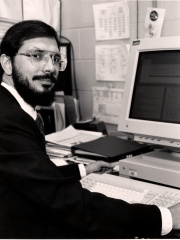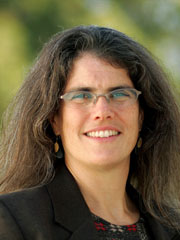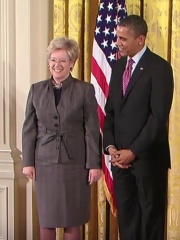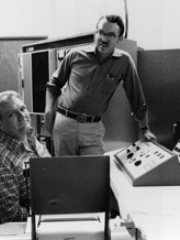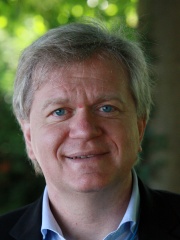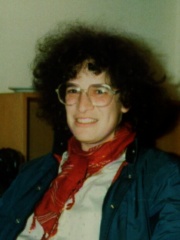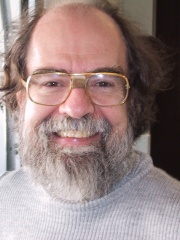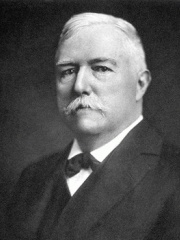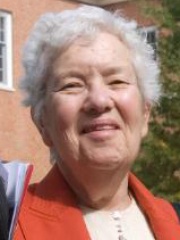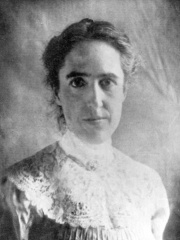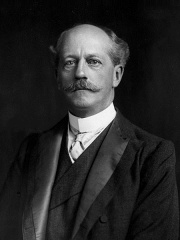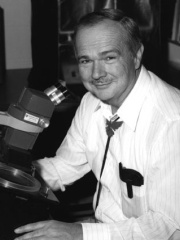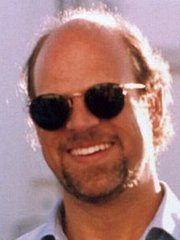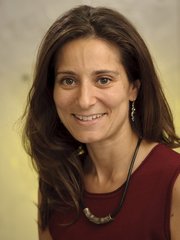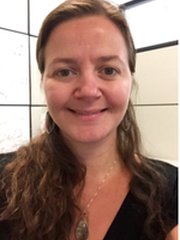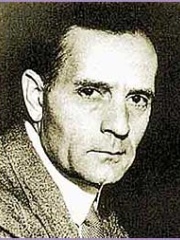
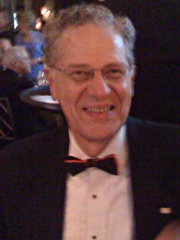
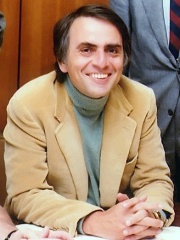
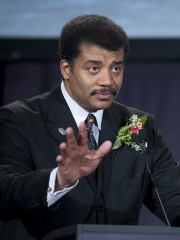
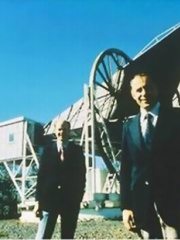
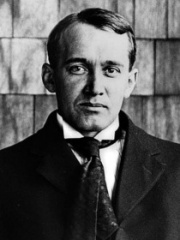
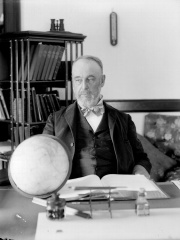
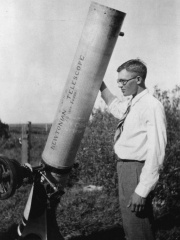
The Most Famous
ASTRONOMERS from United States
This page contains a list of the greatest American Astronomers. The pantheon dataset contains 644 Astronomers, 141 of which were born in United States. This makes United States the birth place of the most number of Astronomers.
Top 10
The following people are considered by Pantheon to be the top 10 most legendary American Astronomers of all time. This list of famous American Astronomers is sorted by HPI (Historical Popularity Index), a metric that aggregates information on a biography's online popularity. Visit the rankings page to view the entire list of American Astronomers.

1. Edwin Hubble (1889 - 1953)
With an HPI of 78.45, Edwin Hubble is the most famous American Astronomer. His biography has been translated into 98 different languages on wikipedia.
Edwin Powell Hubble (November 20, 1889 – September 28, 1953) was an American astronomer. He played a crucial role in establishing the fields of extragalactic astronomy and observational cosmology. Hubble proved that many objects previously thought to be clouds of dust and gas and classified as "nebulae" were actually galaxies beyond the Milky Way. He used the strong direct relationship between a classical Cepheid variable's luminosity and pulsation period (discovered in 1908 by Henrietta Swan Leavitt) for scaling galactic and extragalactic distances. Hubble confirmed in 1929 that the recessional velocity of a galaxy increases with its distance from Earth, a behavior that became known as Hubble's law, although it had been proposed two years earlier by Georges Lemaître. The Hubble law implies that the universe is expanding. A decade before, the American astronomer Vesto Slipher had provided the first evidence that the light from many of these nebulae was strongly red-shifted, indicative of high recession velocities. Hubble's name is most widely recognized for the Hubble Space Telescope, which was named in his honor, with a model prominently displayed in his hometown of Marshfield, Missouri.

2. Joseph Hooton Taylor Jr. (b. 1941)
With an HPI of 77.51, Joseph Hooton Taylor Jr. is the 2nd most famous American Astronomer. His biography has been translated into 66 different languages.
Joseph Hooton Taylor Jr. (born March 29, 1941) is an American astrophysicist and Nobel Prize laureate in Physics for his discovery with Russell Alan Hulse of a "new type of pulsar, a discovery that has opened up new possibilities for the study of gravitation."

3. Carl Sagan (1934 - 1996)
With an HPI of 76.23, Carl Sagan is the 3rd most famous American Astronomer. His biography has been translated into 101 different languages.
Carl Edward Sagan (; SAY-gən; November 9, 1934 – December 20, 1996) was an American astronomer, planetary scientist and science communicator. His best known scientific contribution is his research on the possibility of extraterrestrial life, including experimental demonstration of the production of amino acids from basic chemicals by exposure to light. He assembled the first physical messages sent into space, the Pioneer plaque and the Voyager Golden Record, which are universal messages that could potentially be understood by any extraterrestrial intelligence that might find them. Initially an assistant professor at Harvard, Sagan later moved to Cornell University, where he spent most of his career. He published more than 600 scientific papers and articles and was author, co-author or editor of more than 20 books. He wrote many popular science books, such as The Dragons of Eden, Broca's Brain, Pale Blue Dot and The Demon-Haunted World. He also co-wrote and narrated the award-winning 1980 television series Cosmos: A Personal Voyage, which became the most widely watched series in the history of American public television: Cosmos has been seen by at least 500 million people in 60 countries. A book, also called Cosmos, was published to accompany the series. Sagan also wrote a science-fiction novel, published in 1985, called Contact, which became the basis for the 1997 film of the same name. His papers, comprising 595,000 items, are archived in the Library of Congress. Sagan was a popular public advocate of skeptical scientific inquiry and the scientific method; he pioneered the field of exobiology and promoted the search for extraterrestrial intelligence (SETI). He spent most of his career as a professor of astronomy at Cornell University, where he directed the Laboratory for Planetary Studies. Sagan and his works received numerous awards and honors, including the NASA Distinguished Public Service Medal, the National Academy of Sciences Public Welfare Medal, the Pulitzer Prize for General Nonfiction (for his book The Dragons of Eden), and (for Cosmos: A Personal Voyage) two Emmy Awards, the Peabody Award, and the Hugo Award. He married three times and had five children. After developing myelodysplasia, Sagan died of pneumonia at the age of 62 on December 20, 1996.

4. Neil deGrasse Tyson (b. 1958)
With an HPI of 74.94, Neil deGrasse Tyson is the 4th most famous American Astronomer. His biography has been translated into 67 different languages.
Neil deGrasse Tyson (US: də-GRASS or UK: də-GRAHSS; born October 5, 1958) is an American astrophysicist, author, and science communicator. Tyson studied at Harvard University, the University of Texas at Austin, and Columbia University. From 1991 to 1994, he was a postdoctoral research associate at Princeton University. In 1994, he joined the Hayden Planetarium as a staff scientist and the Princeton faculty as a visiting research scientist and lecturer. In 1996, he became director of the planetarium and oversaw its $210 million reconstruction project, which was completed in 2000. Since 1996, he has been the director of the Hayden Planetarium at the Rose Center for Earth and Space in New York City. The center is part of the American Museum of Natural History, where Tyson founded the Department of Astrophysics in 1997 and has been a research associate in the department since 2003. From 1995 to 2005, Tyson wrote monthly essays in the "Universe" column for Natural History magazine, some of which were later published in his books Death by Black Hole (2007) and Astrophysics for People in a Hurry (2017). During the same period, he wrote a monthly column in StarDate magazine, answering questions about the universe under the pen name "Merlin". Material from the column appeared in his books Merlin's Tour of the Universe (1998) and Just Visiting This Planet (1998). Tyson served on a 2001 government commission on the future of the U.S. aerospace industry and on the 2004 Moon, Mars and Beyond commission. He was awarded the NASA Distinguished Public Service Medal in the same year. From 2006 to 2011, he hosted the television show NOVA ScienceNow on PBS. Since 2009, Tyson has hosted the weekly podcast StarTalk. A spin-off, also called StarTalk, began airing on National Geographic in 2015. In 2014, he hosted the television series Cosmos: A Spacetime Odyssey, a successor to Carl Sagan's 1980 series Cosmos: A Personal Voyage. The U.S. National Academy of Sciences awarded Tyson the Public Welfare Medal in 2015 for his "extraordinary role in exciting the public about the wonders of science".
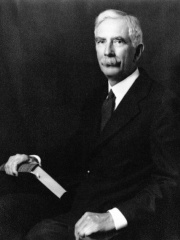
5. Charles Greeley Abbot (1872 - 1973)
With an HPI of 74.64, Charles Greeley Abbot is the 5th most famous American Astronomer. His biography has been translated into 47 different languages.
Charles Greeley Abbot (May 31, 1872 – December 17, 1973) was an American astrophysicist and also the fifth secretary of the Smithsonian Institution, serving from 1928 until 1944. Abbot went from being director of the Smithsonian Astrophysical Observatory, to becoming Assistant Secretary, and then Secretary of the Smithsonian Institution over the course of his career. As an astrophysicist, he researched the solar constant, research that led him to invent the solar cooker, solar boiler, solar still, and other patented solar energy inventions.

6. Robert Woodrow Wilson (b. 1936)
With an HPI of 73.41, Robert Woodrow Wilson is the 6th most famous American Astronomer. His biography has been translated into 78 different languages.
Robert Woodrow Wilson (born January 10, 1936) is an American astronomer who, along with Arno Allan Penzias, discovered cosmic microwave background radiation (CMB) in 1964. The pair won the 1978 Nobel Prize in Physics for its discovery. While doing tests and experiments with the Holmdel Horn Antenna at Bell Labs in Holmdel Township, New Jersey, Wilson and Penzias discovered a source of noise in the atmosphere that they could not explain. After removing all potential sources of noise, including pigeon droppings on the antenna, the noise was finally identified as CMB, which served as important corroboration of the Big Bang theory. In 1970, Wilson led a team that made the first detection of a rotational spectral line of carbon monoxide (CO) in an astronomical object, the Orion Nebula, and eight other galactic sources. Subsequently, CO observations became the standard method of tracing cool molecular interstellar gas, and detection of CO was the foundational event for the fields of millimeter and submillimeter astronomy.

7. Vesto Slipher (1875 - 1969)
With an HPI of 73.27, Vesto Slipher is the 7th most famous American Astronomer. His biography has been translated into 43 different languages.
Vesto Melvin Slipher (; November 11, 1875 – November 8, 1969) was an American astronomer who performed the first measurements of radial velocities for galaxies. He was the first to discover that distant galaxies are redshifted, thus providing the first empirical basis for the expansion of the universe. He was also the first to relate these redshifts to velocity.

8. Asaph Hall (1829 - 1907)
With an HPI of 73.01, Asaph Hall is the 8th most famous American Astronomer. His biography has been translated into 57 different languages.
Asaph Hall III (October 15, 1829 – November 22, 1907) was an American astronomer who is best known for having discovered the two moons of Mars, Deimos and Phobos, in 1877. He determined the orbits of satellites of other planets and of double stars, the rotation of Saturn, and the mass of Mars.

9. Clyde Tombaugh (1906 - 1997)
With an HPI of 72.42, Clyde Tombaugh is the 9th most famous American Astronomer. His biography has been translated into 66 different languages.
Clyde William Tombaugh (; February 4, 1906 – January 17, 1997) was an American astronomer and telescope maker, best known for discovering Pluto in 1930, marking the first detection of what would eventually be recognized as the Kuiper belt. At the time, Pluto was referred to as the ninth planet in the Solar System, a classification that stood for over seven decades. Born in Illinois, and raised on farms in Kansas, Tombaugh was largely self-educated in astronomy and optical engineering, building his own telescopes from spare parts and grinding lenses by hand. His skill and determination led to a position at Lowell Observatory in Flagstaff, Arizona, where he conducted photographic surveys of the night sky. In addition to Pluto, Tombaugh identified hundreds of asteroids and a variety of star clusters, galaxies, and variable stars, thereby contributing significantly to the cataloguing of the night sky. As a professor at New Mexico State University, he led the Planetary Patrol project, which helped determine Mercury's rotation period, monitored Jupiter's Great Red Spot, and developed new photographic techniques for satellite searches. After retiring in 1973, Tombaugh continued to construct telescopes, support observational programs, and advocated continued study of unidentified flying objects (UFOs).
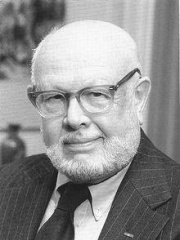
10. William Alfred Fowler (1911 - 1995)
With an HPI of 71.45, William Alfred Fowler is the 10th most famous American Astronomer. His biography has been translated into 71 different languages.
William Alfred Fowler (August 9, 1911 – March 14, 1995) was an American nuclear physicist, later astrophysicist, who, with Subrahmanyan Chandrasekhar, was awarded the 1983 Nobel Prize in Physics. He is known for his theoretical and experimental research into nuclear reactions within stars and the energy elements produced in the process and was one of the authors of the influential B2FH paper.
People
Pantheon has 141 people classified as American astronomers born between 1731 and 2000. Of these 141, 39 (27.66%) of them are still alive today. The most famous living American astronomers include Joseph Hooton Taylor Jr., Neil deGrasse Tyson, and Robert Woodrow Wilson. The most famous deceased American astronomers include Edwin Hubble, Carl Sagan, and Charles Greeley Abbot. As of April 2024, 5 new American astronomers have been added to Pantheon including Kenneth J. Lawrence, R. Paul Butler, and Natalie Batalha.
Living American Astronomers
Go to all RankingsJoseph Hooton Taylor Jr.
1941 - Present
HPI: 77.51
Neil deGrasse Tyson
1958 - Present
HPI: 74.94
Robert Woodrow Wilson
1936 - Present
HPI: 73.41
Russell Alan Hulse
1950 - Present
HPI: 70.19
Andrea M. Ghez
1965 - Present
HPI: 63.93
Sandra Faber
1944 - Present
HPI: 61.03
James W. Christy
1938 - Present
HPI: 60.73
Michael H. Hart
1932 - Present
HPI: 60.05
Stephen P. Synnott
1946 - Present
HPI: 58.95
Brian Schmidt
1967 - Present
HPI: 58.35
Margaret Geller
1947 - Present
HPI: 58.29
James Gunn
1938 - Present
HPI: 58.08
Deceased American Astronomers
Go to all RankingsEdwin Hubble
1889 - 1953
HPI: 78.45
Carl Sagan
1934 - 1996
HPI: 76.23
Charles Greeley Abbot
1872 - 1973
HPI: 74.64
Vesto Slipher
1875 - 1969
HPI: 73.27
Asaph Hall
1829 - 1907
HPI: 73.01
Clyde Tombaugh
1906 - 1997
HPI: 72.42
William Alfred Fowler
1911 - 1995
HPI: 71.45
Edward Emerson Barnard
1857 - 1923
HPI: 70.64
Vera Rubin
1928 - 2016
HPI: 70.42
Henrietta Swan Leavitt
1868 - 1921
HPI: 69.88
Percival Lowell
1855 - 1916
HPI: 69.55
Eugene Merle Shoemaker
1928 - 1997
HPI: 69.36
Newly Added American Astronomers (2025)
Go to all RankingsKenneth J. Lawrence
HPI: 44.42
R. Paul Butler
1960 - Present
HPI: 43.25
Natalie Batalha
1966 - Present
HPI: 36.78
Amy Barger
1971 - Present
HPI: 33.82
Tabetha S. Boyajian
HPI: 32.02
Overlapping Lives
Which Astronomers were alive at the same time? This visualization shows the lifespans of the 25 most globally memorable Astronomers since 1700.

